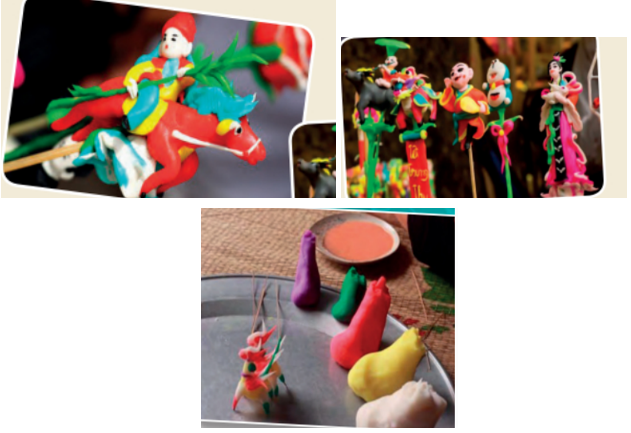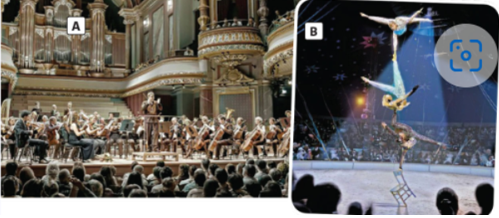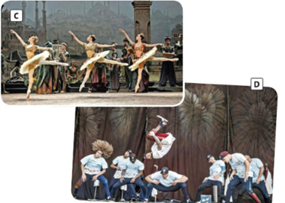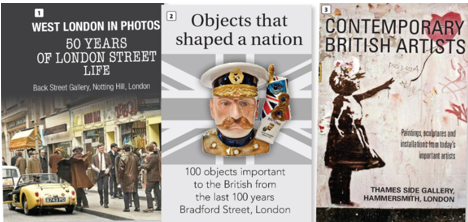Real or fake?
News reader Artist Wolfgang Beltracchi has made millions of pounds from his paintings. However, many of the paintings are not signed with his own name, but with the names of other famous painters. He is the world's most successful forger, and has fooled the art world for over thirty years. Our reporter Jade Quinn has been investigating. How was he finally caught, Jade?
JQ He used the wrong kind of paint in a forgery of a Campendonk painting. The painting had been bought by a company who sent it to a forensic art scientist in London. He identified a type of paint which wasn't being used when Campendonk was alive.
NR That was careless! What happened to Beltracchi?
JQ He was prosecuted and sent to prison for six years.
NR Fifty-eight of his paintings have been identified by police as forgeries and several more are being examined by experts. Are there any more?
JQ Beltracchi himself claims that he has forged hundreds of paintings, but he won't say which ones, so they might never be discovered.
NR What has he done with the money he earned from the forgeries?
JQ He's spent a lot of it, but some of it will be returned to the people who bought his forgeries.
NR Does he still paint in the style of famous artists?
JQ Yes, but now he signs the paintings with his own name.
1 SPEAKING Discuss this question.
(Thảo luận về câu hỏi này.)
Why is a perfect forgery worth less than an original work of art?
(Tại sao một tác phẩm giả mạo hoàn hảo lại có giá trị thấp hơn một tác phẩm nghệ thuật nguyên gốc?)
Bài tham khảo
A: Have you ever wondered why a perfect forgery is worth less than an original work of art?
B: Well, I think it's because an original work of art has historical and cultural significance that a forgery can never match.
A: That's true, but isn't it also because an original work of art has a unique quality and a personal touch that a perfect forgery can't replicate?
B: Yes, definitely. Plus, owning an original work of art is like owning a piece of the artist's legacy, which is priceless.
A: I see your point. It makes sense that a perfect forgery may have the same aesthetic value, but it lacks the emotional and intellectual connection that an original work of art provides.
Tạm dịch
A: Bạn đã bao giờ tự hỏi tại sao một tác phẩm giả mạo hoàn hảo lại có giá trị thấp hơn một tác phẩm nghệ thuật gốc chưa?
B: Chà, tôi nghĩ đó là bởi vì một tác phẩm nghệ thuật gốc có ý nghĩa lịch sử và văn hóa mà một tác phẩm giả mạo không bao giờ có thể sánh được.
A: Điều đó đúng, nhưng không phải vì một tác phẩm nghệ thuật gốc có chất lượng độc đáo và dấu ấn cá nhân mà một tác phẩm giả mạo hoàn hảo không thể sao chép được sao?
B: Vâng, chắc chắn rồi. Thêm vào đó, việc sở hữu một tác phẩm nghệ thuật gốc cũng giống như sở hữu một phần di sản của nghệ sĩ, điều này là vô giá.
A: Tôi hiểu quan điểm của bạn. Điều hợp lý là một tác phẩm giả mạo hoàn hảo có thể có cùng giá trị thẩm mỹ, nhưng nó thiếu sự kết nối về mặt cảm xúc và trí tuệ mà một tác phẩm nghệ thuật gốc mang lại.

Các bài tập cùng chuyên đề
6 SPEAKING Work in pairs. Take turns to tell each other about the last time you did one of the things below. Include the time, place and your feelings.
(Làm việc theo cặp. Thay phiên nhau kể cho nhau nghe về lần cuối cùng bạn làm một trong những điều dưới đây. Bao gồm thời gian, địa điểm và cảm xúc của bạn.)
Cultural activities

2 Read the article above. Was it right to send Beltracchi to prison? Why? / Why not?
(Đọc bài báo trên. Việc đưa Beltracchi vào tù có đúng không? Tại sao đúng / tại sao không?)
1 SPEAKING Work in pairs. Can you recite any poems, lines of poetry or song lyrics by heart in Vietnamese? Were they written recently or a long time ago? Why do you remember them?
(Làm việc theo cặp. Bạn có thể thuộc lòng bất kỳ bài thơ, dòng thơ hay lời bài hát nào bằng tiếng Việt không? Chúng được viết gần đây hay đã lâu rồi? Tại sao bạn lại nhớ đến họ?)
8 SPEAKING Work in pairs. Discuss the opinions in exercise 7. Do you agree with the affirmative or negative version? Give reasons.
(Làm việc theo cặp. Thảo luận về các ý kiến trong bài tập 7. Bạn đồng ý với phiên bản khẳng định hay phủ định? Đưa ra lý do.)
A: I think / don't think rap artists are the best poets these days because...
(Tôi nghĩ / không nghĩ nghệ sĩ nhạc rap ngày nay là những nhà thơ giỏi nhất bởi vì...)
1 SPEAKING Work in pairs. Look at the photo. Do you like the tattoo? Is it a form of art? Does it tell you anything about the woman's personality or not?
(Làm việc theo cặp. Nhìn vào bức hình. Bạn có thích hình xăm không? Nó có phải là một hình thức nghệ thuật không? Nó có cho bạn biết điều gì về tính cách của người phụ nữ hay không?)

6 SPEAKING Work in pairs. Which of these things has your partner done or experienced? Use Have you ever had your...? Ask follow-up questions if appropriate.
(Làm việc theo cặp. Bạn của bạn đã làm hoặc trải qua những việc nào trong số những việc này? Sử dụng Bạn đã bao giờ có...? Đặt câu hỏi tiếp theo nếu thích hợp.)
1 ears / pierce
(tai/xỏ khuyên)
2 hair / dye
(tóc/nhuộm)
3 email account / hack
(tài khoản email / hack)
4 phone / steal
(điện thoại / ăn trộm)
5 portrait / paint
(chân dung / vẽ)
6 fortune / tell
(vận may / xem)
A: Have you ever had your ears pierced?
B: Yes, I have. I had them pierced when I was fifteen.
(A: Bạn đã xỏ lỗ tai bao giờ chưa?
B: Vâng, tôi có. Tôi đã xỏ chúng khi tôi mười lăm tuổi.)
6 SPEAKING Work in pairs. Discuss what kinds of musical genres you enjoy listening to.
(Làm việc theo cặp. Thảo luận về những thể loại âm nhạc mà bạn thích nghe.)
1 SPEAKING Work in pairs. Choose one of the photos and describe it to your partner. Use the words below to help you.
(Làm việc theo cặp. Chọn một trong những bức ảnh và mô tả nó cho đối tác của bạn. Sử dụng các từ dưới đây để giúp bạn.)

Nouns

Verbs

Adjectives

A: In the first photo there's a bus with a patterned wool cover.
(Trong bức ảnh đầu tiên có một chiếc xe buýt với tấm phủ bằng len có hoa văn.)
1 SPEAKING Work in pairs. Match photos A-C with three of the types of show below. Then choose one photo each and describe it to your partner.
(Làm việc theo cặp. Ghép các bức ảnh A-C với ba trong số các loại chương trình dưới đây. Sau đó chọn một bức ảnh và mô tả nó cho bạn của bạn.)

Cultural events and shows

2 SPEAKING Work in pairs. Compare and contrast photos A-C from exercise 1.
(Làm việc theo cặp. So sánh và đối chiếu ảnh A-C từ bài tập 1.)
A: All three photos show...
B: Unlike the other two photos, in photo C you can see...
A: Whereas photo B shows ..., the other two photos...
(A: Cả ba bức ảnh đều cho thấy...
B: Không giống như hai bức ảnh còn lại, trong bức ảnh C bạn có thể thấy...
A: Trong khi ảnh B hiển thị..., hai ảnh còn lại...)
Speaking Strategy 1
Try to use a variety of expressions instead of repeating the same common verbs too often. For example, make sure you know several different ways of saying 'I like' / 'I don't like'.
(Chiến lược Nói 1
Cố gắng sử dụng nhiều cách diễn đạt khác nhau thay vì lặp đi lặp lại các động từ chung quá thường xuyên. Ví dụ: đảm bảo rằng bạn biết một số cách khác nhau để nói của câu 'Tôi thích'/'Tôi không thích'.)
4 KEY PHRASES Read Speaking Strategy 1. Then look at the phrases for expressing preferences. Tick the expression you think is the strongest in each group.
(Đọc Chiến lược nói 1. Sau đó nhìn vào các cụm từ để diễn đạt sở thích. Đánh dấu vào câu mà bạn cho là mạnh nhất trong mỗi nhóm.)
Like
□ I'm a big fan of...
□ I'm quite into...
□ I'm really keen on...
□ I absolutely love...
□ I enjoy ... very much.
Dislike
□ ... is not really my thing.
□ I'm not really into...
□ ... doesn't do anything for me.
□ I've never been that keen on ...
□ I really can't stand...
□ I'm not a big fan of...
6 SPEAKING Work in pairs. Find out your partner's preferences for the shows in exercise 1 and other types of shows you can think of. Use phrases from exercise 4 and Speaking Strategy 2 in your answers.
(Làm việc theo cặp. Tìm hiểu sở thích của bạn của bạn về các buổi biểu diễn trong bài tập 1 và các loại buổi biểu diễn khác mà bạn có thể nghĩ ra. Sử dụng các cụm từ trong bài tập 4 và Chiến lược nói 2 trong câu trả lời của bạn.)
A: What do you think of art exhibitions?
B: I absolutely love them. / To be blunt, I'm not really into them.
(A: Bạn nghĩ gì về triển lãm nghệ thuật?
B: Tôi hoàn toàn yêu họ. / Nói thẳng ra, tôi không thực sự thích chúng.)
1 SPEAKING Work in pairs. What was the last book you read? What was it about? Did you enjoy it? Why? / Why not?
(Làm việc theo cặp. cuốn sách cuối cùng bạn đọc là gì? Cái đó nói về gì thế? Bạn có thích nó không? Tại sao có? / Tại sao không?)
Your teacher has asked you to write an entry for the school magazine. Describe the book and say why you liked it.
(Giáo viên của bạn đã yêu cầu bạn viết một mục mở đầu cho tạp chí của trường. Mô tả cuốn sách và nói lý do tại sao bạn thích nó.)
2 Read the task above and the entry. Did the writer enjoy the book? Did he / she have any reservations?
(Đọc nhiệm vụ trên và mục mở đầu. Người viết có thích cuốn sách không? Anh ấy / cô ấy có đặt bất kỳ cái gì không?)
A
Have you ever read a book that you just couldn't put down? The Hunger Games was like that for me. It's that good! Written by Suzanne Collins in 2006, it's sold millions of copies around the world and has been made into a film.
B
It's set in the future in a place called Panem and it tells the story of Katniss, a sixteen-year-old girl who competes in the Hunger Games with eleven other children. Only one child can survive the games, and Katniss is not optimistic about her chances. There are lots of twists and turns along the way.
C
What I love about the book is the character of Katniss. She's really strong and sensitive. She is practical-minded and loves freedom. She is also quick at getting the information and memorising things. I really identify with her. The story is very gripping. It is hard to put the book down once you start reading it.
D
All in all, this book is a real page-turner. I absolutely love it and I'd definitely recommend it. So if you haven't read it yet, buy it or borrow it. You won't be disappointed.
1 SPEAKING Look at the photos. Do you know what this art form is? Did you use to have any toy of this kind?
(Nhìn vào những bức ảnh. Bạn có biết loại hình nghệ thuật này là gì không? Bạn đã từng sở hữu món đồ chơi nào như thế này chưa?)

6 SPEAKING Work in groups. Discuss the question.
(Làm việc nhóm. Thảo luận câu hỏi.)
What are the benefits which chidren's traditional games like to he can bring about?
(Những trò chơi truyền thống của trẻ em như tò he có thể mang lại những lợi ích gì?)
Work in pairs. You and a classmate are planning a surprise for a friend to celebrate his/her birthday. You would like to take him/her to a concert. Decide which show is most suitable and discuss the arrangements for the outing. Use the ideas below to help you.
(Làm việc theo cặp. Bạn và một người bạn cùng lớp đang lên kế hoạch tạo bất ngờ cho một người bạn nhân dịp sinh nhật của anh ấy / cô ấy. Bạn muốn đưa anh ấy / cô ấy đến một buổi hòa nhạc. Quyết định chương trình nào phù hợp nhất và thảo luận về việc sắp xếp cho chuyến đi chơi. Sử dụng các ý tưởng dưới đây để giúp bạn.)
• When to go to the concert
• The type of concert
• Getting tickets
• Transport to and from
• Food and drink
• Keeping the surprise a secret
(• Khi nào đi xem hòa nhạc
• Loại hình hòa nhạc
• Nhận vé
• Vận chuyển đến và đi
• Đồ ăn thức uống
• Giữ bí mật về điều bất ngờ)
3. Listen again and complete the sentences from the monologues. Use them to help check your answers to exercise 2.
(Nghe lại và hoàn thành các câu từ đoạn độc thoại. Hãy sử dụng chúng để giúp kiểm tra câu trả lời của bạn cho bài tập 2.)
1 Let’s __________ ___________ this: I’m glad Katy liked it!
2 That was __________ ___________ surprise – there was only one part.
3 With a lot of the pictures, it was __________ ___________ the point.
4 He claims it’s much better than today’s pop music, but __________ ___________
Photo comparison and role – play
I can compare photos and role – play a discussion.

1. Look at photos A and B. What types of show are they? Match them with two of the types of show below.
(Nhìn vào ảnh A và B. Đó là loại chương trình gì? Hãy nối chúng với hai trong số các kiểu trình diễn dưới đây.)

2. Read the task. Then complete the sentences in your own words to compare the photos in exercise 1. Write one additional sentence to say which show you think is more appealing.
(Đọc nhiệm vụ. Sau đó hoàn thành các câu bằng lời của bạn để so sánh các bức ảnh trong bài tập 1. Viết thêm một câu để cho biết bức tranh nào bạn cho là hấp dẫn hơn.)
1 Both photos show _____________________________
2 Whereas photo B shows acrobats, photo A _____________________________
3 Unlike photo A, in photo B the audience are sitting _____________________________
4 _____________________________
3. Read Speaking Strategy 1. Then complete the phrases with the words below.
(Đọc Chiến lược Nói 1. Sau đó hoàn thành các cụm từ với các từ bên dưới.)

1 I'm (not) a big __________ of …
2 I'm __________ into … / I’m not really into...
3 I'm really / I've never been that __________ on …
4 I __________ love …
5 I really can't __________ …
6 l enjoy ... very __________
7. … is not really my __________
8... doesn't __________ anything for me.
4. Read Speaking Strategy 2. Complete the phrases with the words below.
(Đọc Chiến lược Nói 2. Hoàn thành các cụm từ với các từ bên dưới.)

Speaking Strategy 2
We often use one of the phrases below to introduce a preference, particularly when it is negative.
I'm 1_______ …
I must 2_______ …
To be 3_______
If 4_______ honest, …
To 5_______ blunt, ….
Personally,…
5. Write two sentences about something you dislike (a type of music, sport, show, etc.). Use one phrase from exercise 3 and one phrase from Speaking Strategy 2.
(Viết hai câu về điều bạn không thích (một loại âm nhạc, thể thao, chương trình, v.v.). Sử dụng một cụm từ trong bài tập 3 và một cụm từ trong Chiến lược nói 2.)
1 _______________________________________________
2 _______________________________________________
6. You are going to do the task in exercise 2. Look at photos C and D below.
(Các em sẽ làm bài tập 2. Quan sát hình C và D bên dưới.)
Your choice: C ☐ D ☐
Why this one?
_______________________________________________
Why not the other?
_______________________________________________

7. Now do the speaking task comparing photos C and D. Use your notes from exercises 5 and 6.
(Bây giờ hãy làm bài nói so sánh ảnh C và D. Sử dụng ghi chú của bạn từ bài tập 5 và 6.)
Speaking
3. Work in pairs. You are staying with your English penfriend and want to go to an exhibition where you will learn more about British culture. Express your opinions about the three exhibitions. Which one will you go to see? Justify your choice and say why you are rejecting the other options.
(Làm việc theo cặp. Bạn đang ở cùng với người bạn qua thư người Anh và muốn đi tham dự một cuộc triển lãm nơi bạn có thể tìm hiểu thêm về văn hóa Anh. Bày tỏ ý kiến của bạn về ba cuộc triển lãm. Bạn sẽ đi xem cái nào? Giải thích cho sự lựa chọn của bạn và nói lý do tại sao bạn từ chối các lựa chọn khác.)







